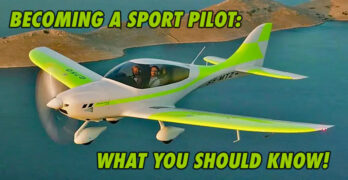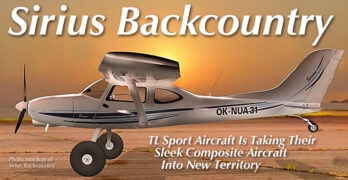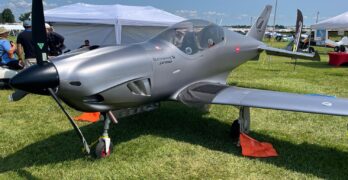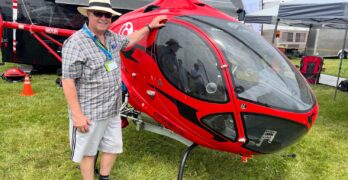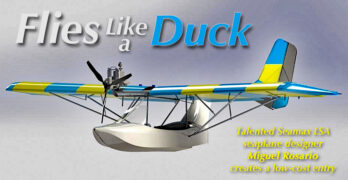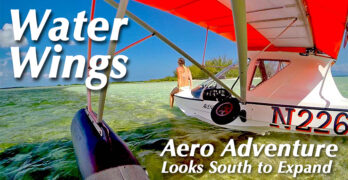Few legacy GA aircraft are as easily recognizable as the Ercoupe. The twin tails and large glazed canopy are distinctive, as are its lack of rudder pedals (on most models). Ercoupe Owner’s Club Executive Director Gene Bunt says, “for lack of a better explanation…it’s got major ‘cute factor’.” But apart from its unique looks, the plane is also known for being easy to fly. It was, after all, designed with the goal of being the safest fixed wing aircraft available—one that would not stall or spin.
While the Ercoupe is a type certified aircraft, many of the variants qualify within the Light Sport category. When MOSAIC comes in all of them will qualify. That’s great news for Sport Pilots looking for something “different” to fly. And, they regularly show up for sale for comparatively little money.
Development
Fred Weick, an aeronautical engineer who would later create the Piper Pawnee and have a hand in designing the Piper Cherokee, designed the Ercoupe after joining the newly formed Engineering and Research Corporation (ERCO) in 1936.
Search Results for : mosaic
Not finding exactly what you expected? Try our advanced search option.
Select a manufacturer to go straight to all our content about that manufacturer.
Select an aircraft model to go straight to all our content about that model.
Sport Pilot Certificate – What You Need to Know
The Sport Pilot Certificate has emerged as a popular option for aspiring pilots who want to experience the joy of recreational flying without the extensive time and financial commitment required for a Private Pilot Certificate. It’s been with us for two decades but there are still questions about the SP certificate. Here’s a rundown.
There are seven main categories of aircraft for which you can be a Sport Pilot, each with variations on training and pilot requirements specific to that Category. This article will be specific to the Airplane Category.
What is the Sport Pilot Certificate?
The Sport Pilot Certificate allows pilots to fly a Light Sport Aircraft (LSA). These aircraft are typically smaller, simpler and more affordable to operate. Key characteristics of LSAs include:
Maximum takeoff weight of 1320 pounds (or 1430 for seaplanes)
Maximum airspeed in level flight of 120 knots under standard atmospheric conditions
Maximum stall speed of 45 knots in landing configuration
Single, non-turbine engine
Fixed pitch or ground adjustable propeller
Fixed landing gear (except for seaplanes)
Note that all of these are under the current LSA/SP rules and are likely to change when MOSAIC becomes reality next year.
Taking Composites “Out Back” — TL Sport Aircraft’s Sirius Backcountry and SE Models
Metal or Fabric… that’s mainly been your choice when you look at LSA that can venture into unimproved landing strips. Composite aircraft with snugly-faired wheels and slippery, shiny exteriors usually stay on civilized airports. You’ve never seen a Cirrus land on a rocky creek bed, have you?
Czech producer TL Ultralight has started down this path and showed a mockup (using images) at EAA AirVenture Oshkosh 2024.
Additionally, recent years have seen several high wing models introduced by LSA manufacturers known for their low-wing designs. High wing aircraft are often considered more versatile on floats or on big tundra tires, though we’ve seen low-wing variations like Bristell’s tundra tire-equipped TDO (Tail Dragger Option).
Thanks to a well-established production facility paired with computer-aided design, importer TL Sport Aircraft will take its all-composite Sirius into backcountry flying.
Summer Celebration
Oshkosh brings out the best in new aircraft.
Blackshape Prime Veloce: Speeding at Mach 2 Standing Still
There are a lot of sexy looking airplanes displayed at AirVenture, but a sure front runner for sleekest looking plane around is the Prime Veloce all-composite, two-place tandem retractable sport plane from Monopoli, Italy. This little speedster is powered by a Rotax 915 iS and is listed as capable of a 170 knot cruise speed. It stalls at 45 knots with full flaps and 57 knots clean.
There are about 70 Prime Veloce aircraft flying in the rest of the world and Blackshape Aircraft, out of Sheridan, Indiana, will be importing them to the U.S. They are hoping to market the Prime Veloce as a completed aircraft, counting on MOSAIC regulations to empower them to accomplish that task. This “mosaic-ready” aircraft will carry 26 gallons of fuel and should be capable of 1,650 feet per minute climb at maximum takeoff weight. Blackshape will list the aircraft, depending on configuration at about $330,000.
Cicaré 8 Kit Helicopter Debuts at AirVenture
It is hard to miss the sexy, sleek, Ferrari-red two-place helicopter on the Ultralight field at AirVenture. It’s new, it’s beautiful, and, as it turns out, it is a kit which can be completed in 200 hours, or even faster at a Cicaré builder assist facility. The two-place Cicaré 8 helicopter is appearing at AirVenture for the first time, made possible by Keith Barr, the President and CEO of the newly formed Cicaré USA corporation.
If the Cicaré name rings a bell, it is because of Augusto Cicaré, who moved from Italy to Argentina at age 19 to start and build what is now the storied Cicaré Helicopter Company. Cicaré has been designing and building helicopters for the Argentinian civilian and military since the early 1960s. Although Augusto died in January of 2022, his sons have continued the business, with great success.
The two place side by side Cicaré 8 was designed in Argentina in 2015.
If It Flies Like a Duck and Floats Like a Duck, Maybe It IS a Duck
Article Updated July 17, 2024 — After this article was posted, Miguel Rosario reported, “Duck is still in tests. Now we will install a 912 ULS 80-horsepower engine, as requested by future customers.” He continued, “Molds are under construction for production, which we hope to start in three months” (approximately October 1, 2024). He finished, “I will keep you updated on all developments regarding Duck.” —DJ
You probably know Seamax. This longtime, performance-oriented LSA seaplane was one of the first to make a splash in the U.S. light aircraft market way back in December, 2007.
Today, regretfully, the Seamax company is going through some very difficult circumstances as noted in this State of the Seaplane Sector report. We don’t know the end of those stories yet.
Nonetheless, Seamax M-22 designer Miguel Rosario remains active. You can’t keep a good man down but apparently you can keep him on the water.
Paths to Affordability
It’s become almost folklore. The quest for affordability in the world of general aviation has been like trying to see the aurora on a cloudy night, or recalling a dog set loose on a squirrel in the forest, or even encountering Bigfoot. From the crash of the post-WW-II airplane buying frenzy, to the mid-1980s liability-fueled dissolution of the general aviation manufacturing industry, to the relative lack of affordability following what the introduction of LSA promised to be, we’re still here, waiting for a real solution.
Parallel paths toward increased affordability exist. One is hopeful and one is tangible.
On the hopeful side we have MOSAIC, which promises to increase capability and affordability within the LSA category by expanding Sport Pilot privileges and making a range of aircraft available to pilots limited to those privileges. Moreover, the MOSAIC-style LSAs could get a lot heavier and faster and more capable—including potential use at night and in instrument conditions.
A Seaplane You Can Afford; Aero Adventure Begins a New Chapter for the Aventura Line
Here’s the backdrop of today’s update on the LSA seaplane sector as summer approaches.
According to Law360, an online legal news source, “Light-Sport Aircraft manufacturer Icon Aircraft filed for Chapter 11 protection in Delaware bankruptcy court with more than $170 million in debt and plans for an asset sale and liquidation.” You may have read (here) that Icon got an initial offer of $13.5 million. As an industry contact told me for the earlier report, “That would hardly make a dent in their liabilities.” The person was right, it appears. A proposed new buyer referenced in the earlier article agreed to take on Icon’s debt but the sales must still go through an auction process, I was told.
OK, let’s come back to Earth… or water perhaps …or either. Aero Adventure continues to fly as it has for three decades (though management has changed at least three times over the period).
Looking Back to See Ahead — Dan Johnson Recalls the Beginning of the LSA Movement
As we move toward MOSAIC as a new reality in the Light Sport/Sport Pilot world, it’s worth knowing how we got here. MOSAIC does, after all, leverage right off of the success of the LSA category. In this casual conversation, I chat with Dan Johnson about the early days of LSA and get some questions answered on how some decisions came to be made.
Reorganization Approved: Van’s Emerges From Chapter 11
While the world of LSAs is diverse enough that the trials of Van’s Aircraft, which put itself into Chapter 11 bankruptcy protection late last year, aren’t quite the foundational matters they are among the homebuilt crowd, the fact that Van’s is represented with the popular RV-12 and companies that support it are also part of the LSA ecosystem suggests more than a little spillover. In the background, Van’s has been working hard to reset its business and emerge from Chapter 11. And on May 15 the company received good news in the form of an Oregon judge approving the company’s reorganization plan. While it seemed unlikely, there was always the possibility that the court would reject or modify the company’s proposal.
In the proposal, Van’s has agreed to repay unsecured creditors 55% of the money they’re owed over three years on top of an “immediate” repayment of $3350 for those in the unsecured creditor class.
- « Previous Page
- 1
- …
- 4
- 5
- 6
- 7
- 8
- …
- 15
- Next Page »



